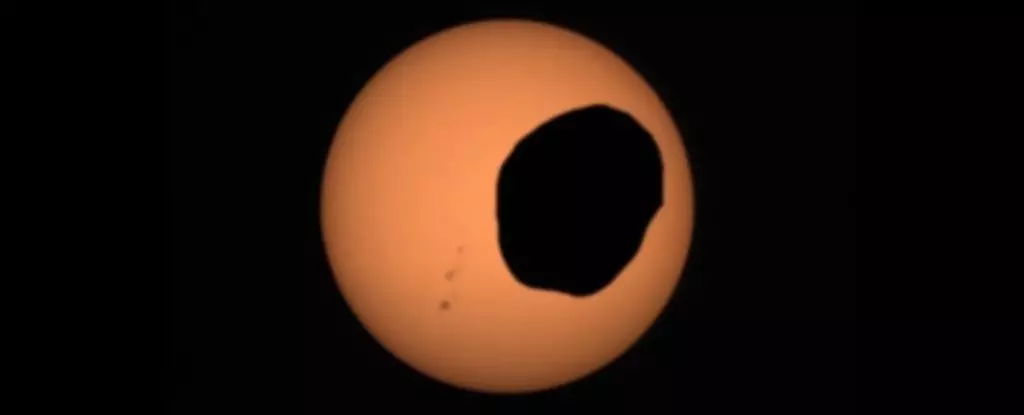Our planet, Earth, is undoubtedly extraordinary, with its numerous astonishing characteristics. However, it is important to remember that our neighboring planet, Mars, also possesses certain noteworthy features. One such remarkable occurrence is the eclipses that take place on Mars, where its moons cast shadows on its surface. Although similar to Earth, these Martian eclipses are distinct and captivating. NASA’s rovers Opportunity, Curiosity, and Perseverance have captured these extraordinary events, providing us with valuable insights into Mars’ natural phenomena.
Mars has two moons, Phobos (“fear” in Ancient Greek) and Deimos (“dread”). Unlike Earth’s moon, these Martian moons have relatively short orbital periods of 7.65 and 30.35 hours respectively. Furthermore, they are significantly smaller and more irregular in shape. Rather than the smooth, round disk of our Moon, Phobos and Deimos could be likened to lumpy “moontatoes.” Consequently, the eclipses on Mars, technically known as transits, differ from the eclipses we observe on Earth. The Martian moonlets do not completely block out the Sun’s light when they pass between the Sun and observers on the Martian surface.
Imagine looking up at the Martian sky during one of these transits – the Sun appearing as a giant eyeball with an uncanny pupil. Although this image may seem fanciful, it is a perspective that scientists have contemplated. Interestingly, when Phobos’ shadow passes over Mars, scientists have observed a peculiar effect. The Mars InSight lander, designed to measure seismic activity, experiences a slight tilt during these events. Researchers attribute this subtle inclination to the deformation of Mars’ surface caused by the minimal cooling effect resulting from reduced solar radiation.
Mars’ two moons have contrasting effects on the sunlight they block. Phobos, the larger moon, can obscure up to 40 percent of the Sun’s light, even when it is completely engulfed by the Sun’s glare. On the other hand, Deimos, smaller and farther away, blocks significantly less sunlight. These differing levels of obstruction accentuate the uniqueness of our own planet, Earth. During a total solar eclipse on Earth, the Moon perfectly covers the Sun’s disk, despite its relatively smaller size. This peculiarity is due to a captivating coincidence – the Moon is approximately 400 times smaller than the Sun but also around 400 times closer to Earth. As a result, the Moon and the Sun appear almost identical in size in our sky, allowing for the phenomenon of a total solar eclipse.
The synchronous size relationship between the Moon and the Sun on Earth is a fascinating occurrence, particularly considering the emergence of our species at the perfect moment to witness such ideal eclipses. However, this scenario is temporary. The Moon initially orbited much closer to Earth and is gradually moving away at a rate of approximately 3.82 centimeters (1.5 inches) per year. In about 600 million years, total solar eclipses will no longer be possible on Earth, highlighting the transient nature of these magnificently precise celestial alignments.
Solar eclipses observed from Earth are not only visually captivating but also provide valuable scientific insights about the Sun. Moreover, they have historically offered critical testing opportunities for theories like general relativity. Similarly, on Mars, scientists can utilize eclipses to enhance their understanding of the planet and its moons. By studying the motion of Phobos and its gravitational impact on Mars, researchers gain valuable information about the mysterious interior of the planet. Additionally, these observations enable scientists to make predictions about the fate of Phobos. As the moon moves closer to Mars over time, its gravitational pull will eventually cause it to disintegrate. At that point, Mars may temporarily become surrounded by a ring of Phobos debris. Continuously tracking the paths of Phobos and Deimos across the Martian sky provides data that aids in mapping and predicting this dramatic event.
The eclipses on Mars offer a captivating and unique spectacle. The transits of the Martian moons result in intriguing shadows but not the complete darkness experienced during eclipses on Earth. These lunar events allow us to appreciate the extraordinary nature of Earth’s perfect solar eclipses, which will eventually become a thing of the past due to the Moon’s gradual departure. By studying and analyzing the eclipses on Mars, scientists gain valuable insights not only about the Red Planet but also about the nature of celestial bodies and their interactions. As we continue to explore the mysteries of the universe, these eclipses serve as a reminder of the diverse and wondrous phenomena our cosmos has to offer.


Leave a Reply